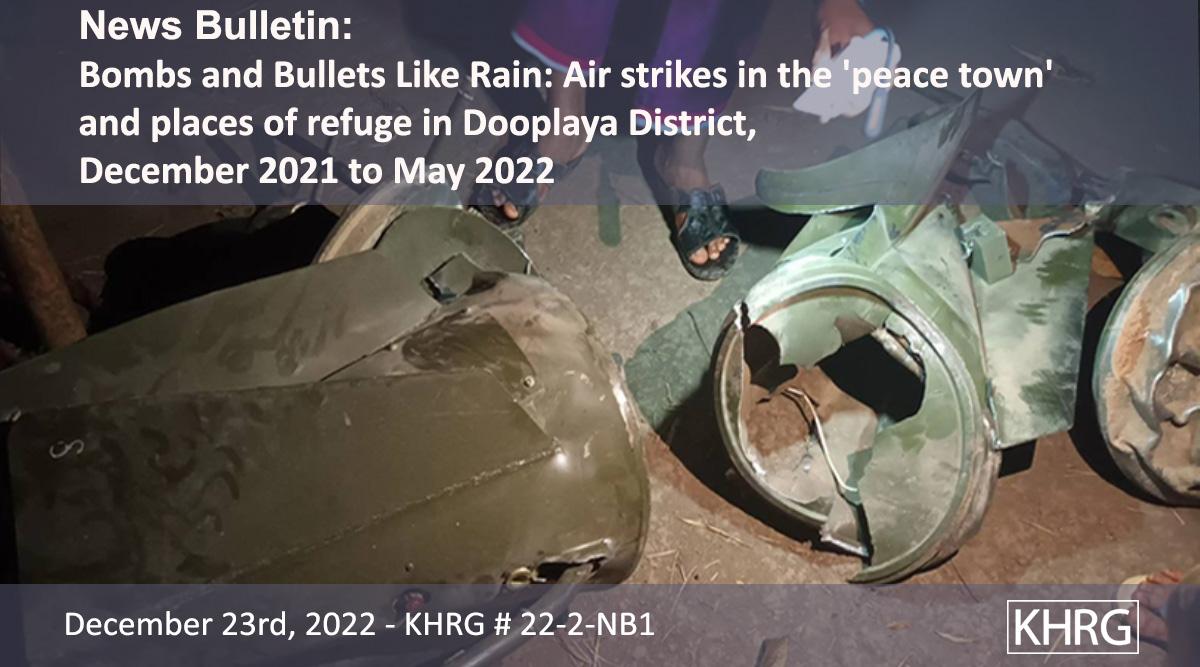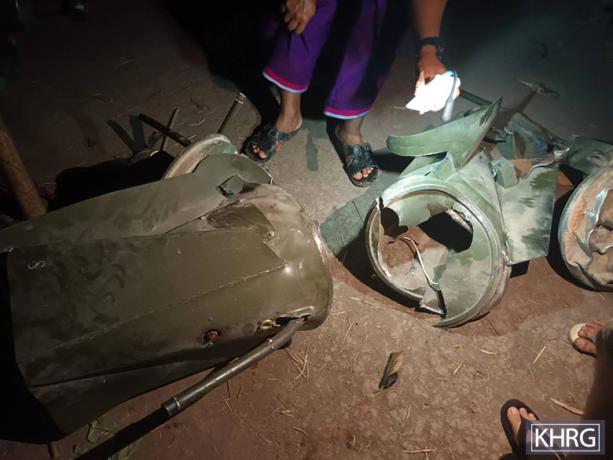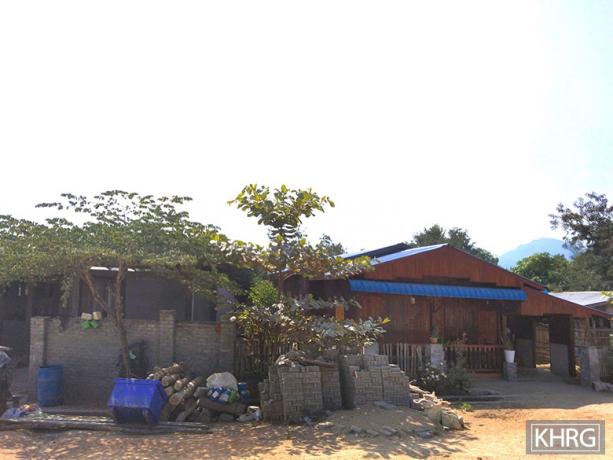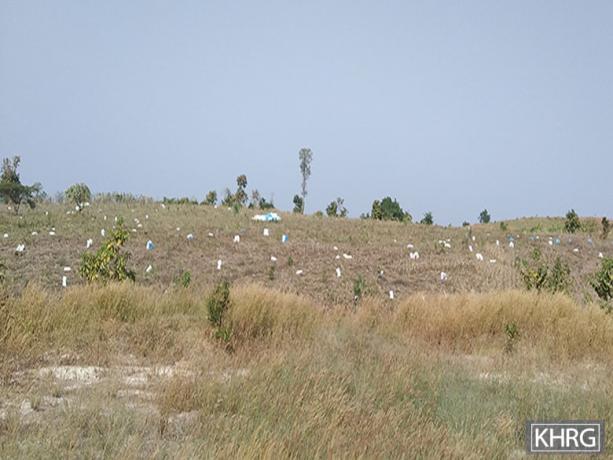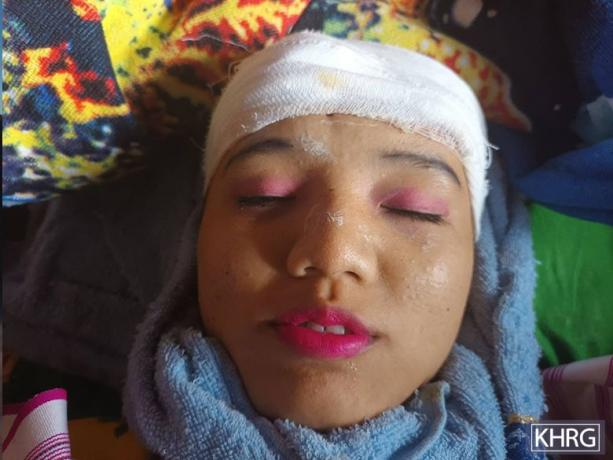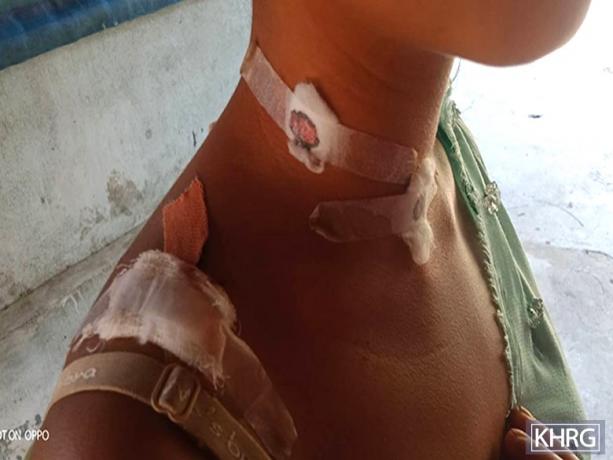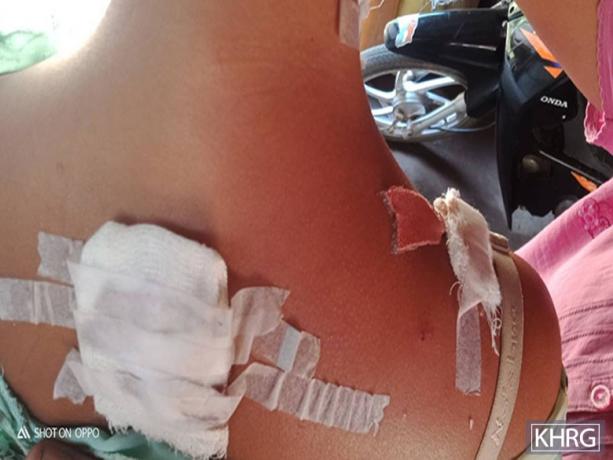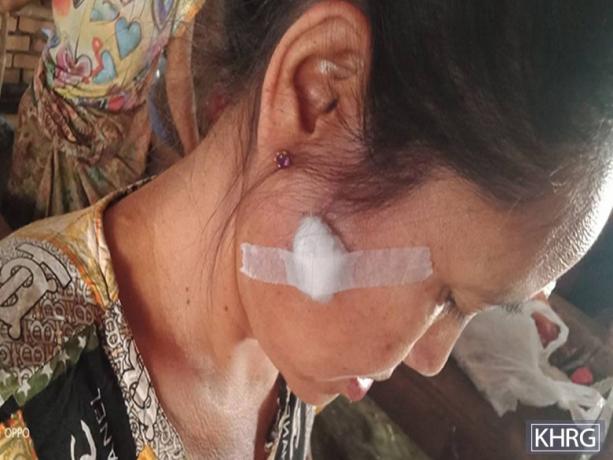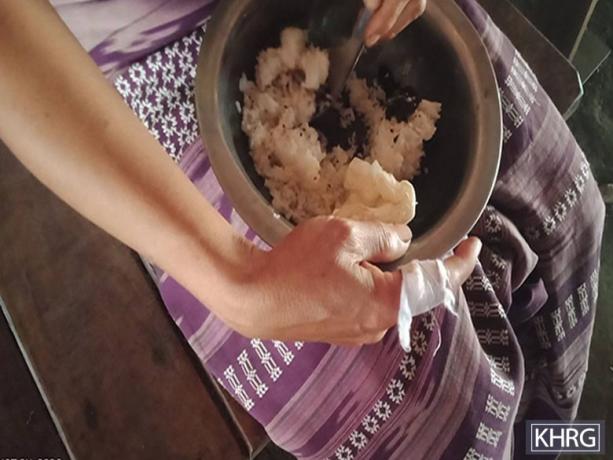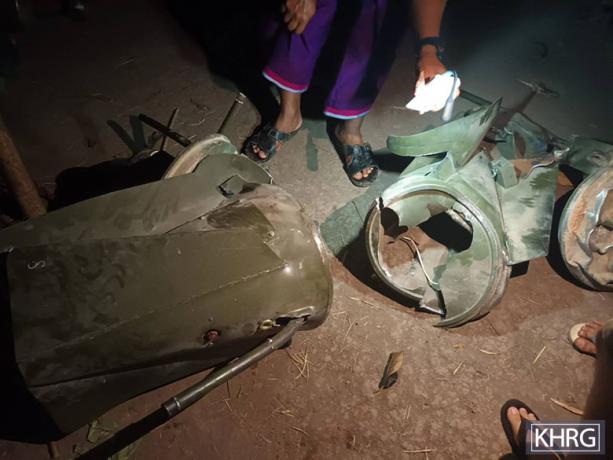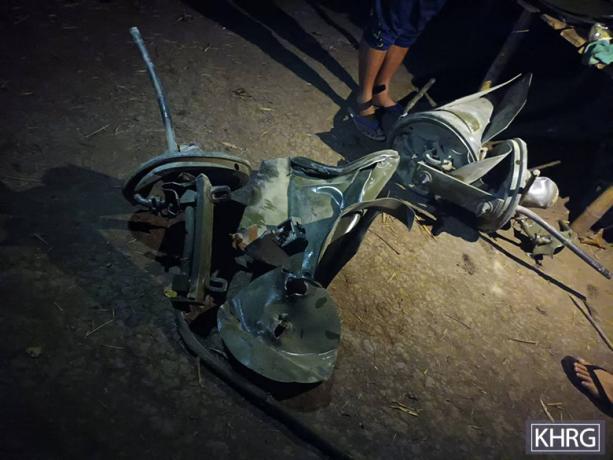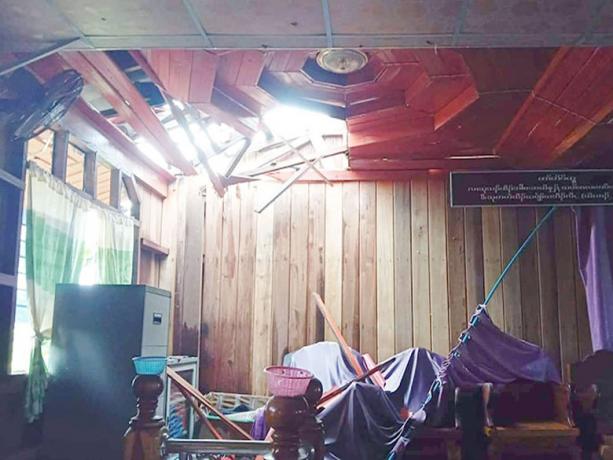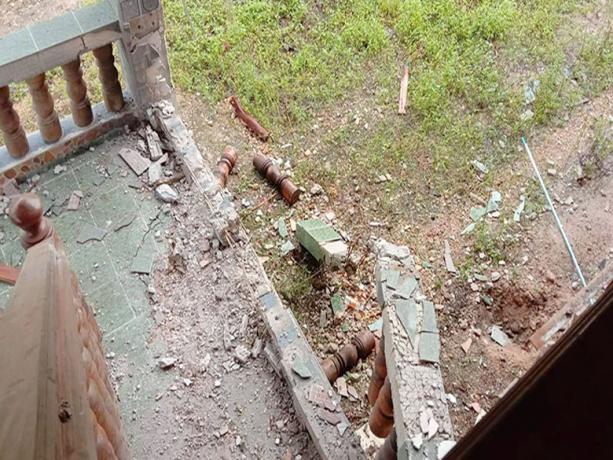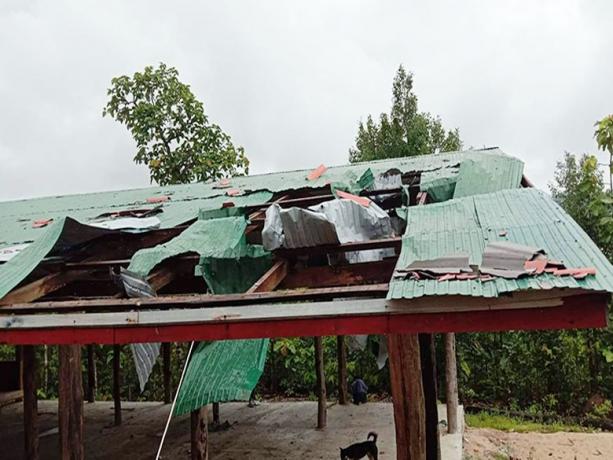Introduction
The first air strikes in Dooplaya District took place on December 23rd 2021. Up until that time, the air strikes that followed the 2021 military coup were primarily concentrated further north in Mu Traw (Hpapun) and Kler Lwee Htoo (Nyaunglebin) districts, and had (temporarily) ceased after April 2021. An additional air strike was launched in Mu Traw District in November 2021, but the air strikes that took place in Dooplaya District in December 2021 marked an increased reliance on air attacks in the junta’s offensives and in its ongoing onslaught against civilians. From December 2021 to May 2022, there were at least 23 air strikes reported in Dooplaya District.
Information received by KHRG shows eight people injured (but no deaths) resulting from those 23 air attacks, however, the number of casualties is likely higher as reporting from many areas has been difficult. The military junta had also been actively conducting air reconnaissance with jets and helicopters since the coup, which led to widespread displacement, as villagers are unable to know whether aircraft flying over their villages are only engaging in surveillance or may also drop bombs and fire weapons. In many cases the air strikes were combined with ground attacks, which resulted in additional casualties: 15 injured and six dead according to information received by KHRG.[1] Heavy displacements and property damage due to ground attacks were also reported.
Even prior to the December 2021 air strikes, there had been pressure not to engage in further air offensives. On December 20th 2021, the Karen National Union (KNU)[2] released a “No Fly Zone” statement to prevent air strikes from happening like earlier in Mu Traw and Kler Lwee Htoo districts, which resulted in the death of at least 16 civilians, injury to at least 25, and the displacement of anywhere between 25,000 to 70,000 villagers.[3] The International Karen Organisation (IKO) also called upon the United Nations for the establishment of a “No Fly Zone” on December 21st 2021.[4]
The first air strikes in Dooplaya District in December 2021 led to the displacement of tens of thousands of villagers. Many of those forced to flee were already displaced persons from other areas, having fled to Dooplaya District in search of protection. Since the early months of the 2021 coup, the KNU and villagers in areas under KNU control had provided refuge and assistance to people who had joined the Civil Disobedience Movement (CDM)[5] or had participated in the pro-democracy protests and feared arrest and violence by State Administration Council (SAC)[6] security forces.
In fact, the air attacks in Dooplaya District have been linked to the heavy presence of pro-democracy activists, CDM participants, and National League for Democracy (NLD) leaders who sought refuge there. The attacks have heavily targeted civilian areas, including protected sites like schools and churches, and have often taken place in the middle of the night. The December 2021 air attacks on Lay Kay Kaw Town received substantial attention in the media due not only to the scale of the attacks but also the symbolic role of Lay Kay Kaw as a ‘peace town’ created in 2015 at the time of the Nationwide Ceasefire Agreement (NCA)[7] through the initiative and funding of the Nippon Foundation. While air offensives in Dooplaya District have steadily continued since December 2021, international media attention has seriously waned.
This news bulletin provides an overview of the air strikes that took place from December 2021 through May 2022 in Dooplaya District.[8]
First series of air strikes
After the 2021 coup, as arrests and threats of violence against pro-democracy activists, CDM participants, and NLD political leaders increased, many of these people fled toward the border and found refuge in parts of Dooplaya District. By the end of May 2021, there were already a reported 3,000 CDM arrivals in the district.[9] KHRG researchers reported an increase in SAC activity as early as October 2021 in Kaw T’Ree (Kawkareik) Township, including the establishment of new security checkpoints and increased monitoring of travel in and out of towns. In December, villagers reported increased inspections and the movement of SAC troops through their villages.
Tensions increased between the SAC and Karen National Liberation Army (KNLA)[10] after the SAC began searching for NLD members, civil servants and activists in the KNU controlled area of Lay Kay Kaw Town, Kaw T’Ree Township. According to a KHRG researcher, on December 14th 2021, SAC troops entered Lay Kay Kaw New Town to look for those who were participating in the CDM. KNU leaders gave them permission only to investigate, take notes, and take pictures. However, SAC Light Infantry Battalion (LIB)[11] #275 and Border Guard Force (BGF)[12] Battalion #1013 entered Lay Kay Kaw New Town and forcefully arrested whoever they saw. Villagers from Lay Kay Kaw who were able to escape said that the SAC arrested more than 30 villagers. As a consequence of the unauthorized raids and illegal arrests, fighting broke out between the combined SAC and BGF troops and the KNLA on December 15th at 10:30 am. Following this fighting, the SAC reinforced their troops in the area and carried out heavy attacks on the ground as well as in the air.[13]
Lay Kay Kaw New Town was first established in 2015, as a resettlement site where refugees who had fled to Thailand during past periods of conflict could return to re-establish their lives in Burma. It is situated close to the border with Thailand and about 14.5 km south of Myawaddy Town. It comprises 1,250 units that house over 3,000 residents, mostly former refugees and IDPs.[14] More people arrived after the 2021 coup, seeking refuge.
This first series of air strikes in Dooplaya District lasted for six days. The first air strike was launched on December 23rd at around 10:30 pm in the Lay Kay Kaw area. The next day, at around 3:30 pm, the SAC conducted another air strike at the Lay K’Paw Waterfall, a popular tourist area just outside of Lay Kay Kaw Town. After this, the SAC fired over 50 mortars into Mitta Lin Myaing place [a location where many CDM participants were believed to be in hiding] in Lay Kay Kaw Town.[15] No casualties were reported for the first two days of air strikes. However, over ten thousand villagers in the Lay Kay Kaw area fled to the Thai border. Following the air strike, an SAC base[16] in Lay Kay Kaw Town, Mitta Lin Myaing section indiscriminately shelled about 50 mortars in the area. Meanwhile, the SAC Infantry Battalion (IB)[17] #97, based in Kawkareik Town shelled about 40 mortars into the local villages in the area. This destroyed a villagers’ house in Kaw Nweh village, Kaw Nweh village tract, Kaw T’Ree Township.[18]
The SAC launched an air strike for the third time in Lay Kay Kaw and Htee Meh Wah Hkee village on December 25th 2021 at 1:25 pm. On that day, two SAC helicopters flew over the area, circling twice and firing guns and dropping bombs on Htee Meh Wah Hkee village, and firing guns at the KNLA checkpoint located next to the village. A local community member reported to Karen Information Center (KIC) that more than five civilians were injured in this air strike. Meanwhile, the SAC based in Mitta Lin Myaing also shelled 80 mm mortars into the area.[19]
A local community member told KHRG that the SAC used four aircraft during the attack. Two of the aircraft dropped bombs whereas the other two flew higher for reconnaissance. A displaced villager recounted to KHRG: “People in Lay Kay Kaw could not carry anything because the air strike happened all of a sudden. (…) The SAC dropped bombs and fired machine guns [from helicopters and jets] so bullets [and bombs] fell from the sky just like rain.”
On December 26th 2022 at 6 am, fighting broke out near the KNU Agriculture Department, on the Asia Highway in Kawkareik Town. More than seven SAC soldiers died. Following this, SAC aircraft from Military Operations Command (MOC)[20] #12 based in Kawkareik Town flew over the area and dropped five bombs. There were no damages or casualties reported in this attack.[21]
On December 27th 2022, around 1 pm, the SAC launched another air strike in Lay Kay Kaw Town and the nearby village of Htee Meh Wah Hkee.[22] Earlier in the morning, at 4 am, SAC troops based south of Myawaddy Town shelled more than 100 artillery into the area, before conducting an air strike at midday.[23] Over ten thousand civilians in the Lay Kay Kaw area fled to the Thai-Burma border due to the ground and air attacks. Villagers were displaced from Meh Htaw Th’Lay, Min Leh Pan, P’Loo Hpa Doh, P’Loo Hpoh, Ein Gin Myaing, Lay Kay Kaw, P’Hee Klaw, Htee Meh Wah Hkee, Ya Thay Gu and Thay Baw Boh villages, Myawaddy area, Kaw T’Ree Township. Also, in the area around Kawkareik Town, over 2,000 villagers from Kaw Nweh, T’Tan Koo, Aan Ka Laung, Ka Maing Kon villages have been displaced.[24]
Again, on December 28th 2021, two SAC jets came to drop bombs along the Kaw Nweh Ah Sa road at 1 pm. Local authorities reported to KHRG that no one was injured, no houses were destroyed, and no property was damaged.
Ongoing air strikes (January to May 2022)
From January to May 2022, the SAC military continued to launch air attacks as part of its offensives in Dooplaya District, with most attacks taking place in Kaw T’Ree Township, near Kawkareik Town, Lay Kay Kaw Town and in areas along the Thai-Burma border. Due to ongoing fighting, ground and air attacks, as well as SAC troop presence and occupation of villages, many villagers have remained displaced since December 2021. Some have fled to Thailand, but are generally forced back across the border into Burma.
In January 2022, the SAC carried out a series of air strikes on villages across Kaw T’Ree Township. On January 10th 2022 at 2:30 pm, the SAC launched an air strike into Meh K’Thaw, Ywa Thit Kone, and Peh Th’Raw Doo (Myo Haung) villages, Kaw Nweh village tract, Kaw T’Ree Township. According to the Peh Th’Raw Doo village head interviewed by KHRG, the SAC carried out the air strike using two jets and shelled into the area. The Mu K’Teh monastery in Ywa Thit Kone village was destroyed in the air strike. Before the air strike happened, fighting started on January 8th 2022 along with mortar shelling. As reported to KHRG, “On January 8th, SAC soldiers came into the village [Peh Th’Raw Doo] and fired guns all the time in the village. They slept one night in the village. The next morning, they left the village and fighting happened again on January 10th. As a result, they conducted an air strike on that day.” Due to the shelling, nine people were injured in the village. Three of them were severely injured and six others received only minor injuries.[25] All villagers in the area fled on January 8th 2022, and so there were no further casualties as a result of the air strike on January 10th.
On January 14th 2022, at 12:25 pm, the SAC launched another air strike using helicopters, this time targeting the Democratic Karen Benevolent Army (DKBA)[26] camp (Bo Sa Lone base) in P’Loo Hpoh village, P’Loo village tract, Kaw T’Ree Township. According to Mizzima News, SAC soldiers also looted villagers’ homes after villagers fled, and stole or destroyed three Buddha statues and three jade statues from the DKBA camp.[27]
On February 15th 2022, more sporadic fighting and shelling broke out in areas around Lay Kay Kaw, including P’Loo Hpa Doh [often referred to by villagers as simply P’Loo] village, Meh Wah Hkee village and May Leh Pan village, Kaw T’Ree Township.[28] KIC reported that KNLA troops had launched an attack to take back the hilltop artillery base that had earlier been seized by the SAC and BGF.[29] KHRG previously reported that many households from these villages fled, fearing that the fighting and shelling would get worse.[30] On February 16th at 2:42 pm, two SAC helicopters conducted air strikes for about 15 minutes in P’Loo Hpa Doh village, causing the rest of the villagers hiding in the village to flee. One male villager was seriously injured while he was fleeing to escape from the air strikes, however, is unsure whether he was injured from the air strike or indiscriminate shelling. He was sent to a hospital in Thailand where his right foot was amputated due to injuries from the attack.[31] A church and several houses in P’Loo Hpa Doh village were also damaged due to the indiscriminate shelling and air strikes.
According to a KHRG researcher, about 1,000 IDPs from 350 households from P’Loo Hpa Doh village were displaced, sheltering along the banks of the Moei River. They did not have enough tarpaulins to make both a roof and a floor. When the rain came on February 18th 2022, their shelters were not able to protect them. Many of them fell ill, but did not have access to medicine or even enough clothes to stay dry.[32]
On March 7th 2022, the KNU in Dooplaya District sent a letter to the commander of the SAC military’s Southeastern Command demanding that junta troops withdraw from Lay Kay Kaw and other areas south of Kawkareik Town by March 9th.[33] Villagers in the area remained displaced since the earlier attacks in December 2021 due to the ongoing presence of SAC troops, who were also looting and damaging villagers’ homes and property. According to KNU spokesperson Padoh Saw Taw Nee, rather than withdrawing, more junta troops were brought in and multiple clashes took place. At 5:30 pm on March 9th, the SAC military sent in helicopters and jets and started firing on Lay Kay Kaw Town and surrounding areas.[34] KHRG was unable to gather further information on these events.
On March 25th 2022, at around midday, fighting broke out when troops from the Karen National Defence Organisation (KNDO)[35] and KNLA Company #3 attempted to occupy the SAC army camp in Htee K’Pler village, Su Ka Li village tract, Kaw T’Ree Township. Meanwhile, two SAC aircraft conducted strafing and then dropped six bombs around the Htee K’Pler village area at 11 am. According to a KHRG field researcher, there were no causalities because the bombs landed outside of the village. The displaced people in the area had to flee further to a different location due to the air strikes.
During that time, SAC and BGF combined troops also shelled mortars into Thingannyinaung (a section in Myawaddy Town) and into Htee Moo Hta village, Noh Hpoh village tract, Kaw T’Ree Township.[36] According to an earlier report by KHRG, the shelling into Htee Moo Hta village that took place on March 24th, killed a 17-year-old girl and injured three other villagers.[37]
On March 26th 2022 at around 1 am, SAC military jets came a second time and dropped four bombs in the area: two bombs were dropped in Aoo Kray Hkee village, Su Ka Li village tract, Kaw T’Ree Township and the other two were dropped in Maw Pah Leh village, Meh Naw Aa village tract, Kaw T’Ree Township. A KHRG field researcher reported that the two bombs that landed in Aoo Kray Hkee village did not hit anyone or any buildings. In Maw Pah Leh, two bombs were dropped but only one of the bombs exploded and it damaged five houses and killed three goats. About 3,000 villagers, including people who had already been displaced, had to flee again due to the attack.
Also on March 26th 2022, SAC LIB #559, LIB #560, Light Infantry Divisions (LID)[38] #44 and #11 reinforced their troops at Maw Hkee army camp in Maw Hkee village, Maw Hkee village tract, Kaw T’Ree Township in order to capture it back. It had recently been occupied by KNLA and KNDO troops. The SAC troops marched from Kawkareik Town and when they arrived at Hkler Kloh Place near Thay Baw Boh village at 11 am on March 27th (Armed Forces Day), heavy fighting broke out between the SAC and KNLA/KNDO combined troops. Meanwhile, two SAC helicopters flew over the area and conducted two rounds of air strikes in Bler Doh area on March 27th from 2 pm to 5 pm. Therefore, villagers in Bler Doh, Thay Baw Boh and Lay Gaw villages, Thay Baw Boh village tract no longer felt safe to stay in their villages and fled elsewhere. According to a KHRG researcher, Bler Doh villagers fled to Thailand but Thai soldiers did not allow them to stay, so they had to return to Burma. As of March 28th 2022, fighting was still ongoing and the sound of mortars and guns could still be heard. KHRG received information that 195 people and 54 households were displaced from Bler Doh village. They settled along the banks of the Moei River.
Free Burma Rangers (FBR) reported that SAC fighter jets and helicopters attacked homes and villages (Plaw Hta, Su Ka Li, Kwee Ta Auh, Kwee Ta Hoh, and K’Pler Kwee) in eastern Taw Naw, Kaw T’Ree Township on April 1st 2022. A total of 139 villagers from 27 households fled to Se Pho Khi village on the Thai border. FBR helped to provide food and shelter for the displaced villagers.[39]
On April 3rd to 4th, 2022, SAC aircraft conducted air strikes using helicopters and fighter jets for two days in a row into Klee village, Klee village tract, Kaw T'Ree Township. The air strikes followed two days of fighting, on April 1st and 2nd, between the SAC and KNLA. A villager, Saw D--- recalled, “The fighting [between the KNLA and SAC] started on April 1st and ended on 2nd 2022. A helicopter flew over Klee village on April 3rd and conducted an air strike, shelling [dropping bombs] from 3 to 4 pm. Again, on April 4th 2022, the helicopter came and conducted another air strike, shelling from 8 to 10 am. On April 4th 2022, the shelling [bombs] hit our house and another house in front of mine destroying it all. The wood that I had prepared to build the house is all destroyed.” He, along with six or seven other households, fled to the jungle. However, the local authorities warned them that it was not safe to flee to the jungle because the aircraft could drop bombs there as well. There were no casualties or damages during that first day of air strikes.
On the second day, April 4th 2022, the air strike injured two female villagers in Klee village. As reported to KHRG, they are Naw M---, 45 years old and Naw H---, 23 years old. Naw M--- sustained injuries to her ear and also her finger. Naw H--- was injured on her back. Naw M--- recalled that one shell fell in front of her house and remained unexploded. Moreover, a villager’s house was burned down by the air strike. Local villagers witnessed six bombs being dropped on the second day. One villager, Saw K---, remarked: “Three aircraft came and I didn’t even dare to look up as the air strikes were so heavy.” He added that there are over 347 households in the village, for a total population of 1,791. While some villagers fled to the forest, others fled to nearby villages: Yar Doh village and Lu Thaw Baw village. According to Saw K---, only about 30 to 40 entire households fled, however, many other families fled, leaving behind one person from their household to look after things. It was primarily young women and children who fled. Nevertheless, the majority of villagers stayed in the village, hiding in bunkers rather than flee.
In April 2022, the SAC carried out further air strikes in the Lay Kay Kaw area. On April 10th 2022, fighting broke out between KNLA Cobra Column[40] and the SAC in Lay Kay Kaw Town, and Htee Meh Wah Hkee village and Aee Thay village, P’Loo village tract, Kaw T’Ree Township. Following this, the SAC conducted one air strike at 11:50 am. The SAC fighter jet undertook reconnaissance eight times and continued conducting air strikes. On the same day at 1:30 pm, the SAC fighter jet returned and conducted an air strike again, and then headed back to Kawkareik Town area. This air strike destroyed school buildings donated by the Japanese Nippon Foundation and destroyed more than 30 houses.[41] One source states that there were a total of five air strikes in the Lay Kay Kaw area that day.[42] According to a KHRG researcher, on the same day, from 3:20 pm to 5:00 pm, the SAC conducted reconnaissance again at Lay Kay Kaw Town and in the P’Loo village tract area.
As reported to KHRG, the community members found two of the bombs and one of them had not exploded. The local villagers believed the bombs were chemical bombs because of the effect on those who came close to them or the area where they landed. Villagers who went to investigate the bombs experienced a variety of symptoms. One villager who suffered problems explained to KHRG, “I just feel painful (eye-burning) in my eyes. [… But] I saw them [other exposed people] feel like vomiting, dizzy and eyes burning. […] there were seven people who were affected but two of them suffered the most. They can hardly breathe.” KHRG was unable to confirm whether the bombs were indeed chemical weapons. Those who saw the bomb said that one of them was imprinted with the number 15, and the other with the number 18. According to local villagers, the unexploded bomb was removed by an unknown group, and a landmine was put in its place.
Meanwhile, the SAC based in View Point Kone and BGF at Leh Kat Taung hill fired over 100 mortars into Lay Kay Kaw Town. This damaged over 30 houses, and some burned down as a result of the shelling.[43]
On the morning of April 12th 2022, junta troops based in Thingannyinaung army camp fired shells into Htee Moo Hta village, Noh Hpoh village tract, Kaw T’Ree Township, Dooplaya District. As reported to KHRG, four villagers were injured, including a 6-year-old child. Some villagers fled to other locations, while others remained in the village on alert. At around 10:50 pm, one aircraft from the military junta conducted an air strike in Noh Hpoh village, Noh Hpoh village tract, Kaw T’Ree Township. Two bombs landed in a villager's rice field, and bomb fragments damaged four houses belonging to villagers due to the explosion. A villager who witnessed the aerial attack explained to KHRG, “I saw two bombs drop in front of us and two bombs drop behind us. They also dropped bombs on Ta La Ain Thin monastery [near P’Loo Hpa Doh village] but I could not see them [only hear them] because it was nighttime.” Some villagers fled but some stayed to monitor the situation in the village.
From April 16th to 20th 2022, fighting occurred every day between KNLA Battalion #18, Column #4 and SAC LIB #32 in Klee village, Klee village tract, Kaw T’Ree Township. Two male villagers were injured from shelling that occurred during the fighting. The SAC military also conducted air strikes twice, on April 18th and 19th, during the five days of fighting. Villagers don’t know how many bombs were dropped, but they landed outside the village. A KHRG researcher reported that there were no casualties from the air strikes but two wooden houses were damaged by fragments from the exploded bombs.
On April 20th 2022, around 1 am, one SAC aircraft conducted an air strike in the Lay Kay Kaw area.[44] No casualties were reported.
A KHRG researcher reported that the local KNLA in Kwee Ler Ter village area had been taking control of the area around a stream used by SAC LIB #561 based at Kwee Ler Ter army camp, Kwee Ler Ter village, Noh T’Kaw Township, Dooplaya District. During the second week of April 2022, the SAC wrote a threatening letter to the KNLA saying that if the KNLA did not open the stream within three days, the local villages would face the consequences [face destruction]. On April 21st 2022 between 4 and 5 pm, two SAC aircraft dropped five bombs into Kwee Ler Ter, Th'waw Thaw and Htee Th’Blut Hkee villages, Maw village tract, Noh T’Kaw Township. A KHRG researcher reported that there were no casualties or damages from this attack as the bombs landed in the forest and at the bottom of mountain. Due to the air strikes, more than 500 civilians from five villages displaced to the Thai border.[45] According to KHRG reports from the field, hundreds of local villagers had already been displaced to the Thai Border since the fighting broke out on March 26th 2022 in Th’Waw Thaw village, Maw village tract.
The SAC LIB #559 and IB #32 military camp, which is located to the west of Thay Baw Boh village, was attacked by KNLA troops on May 18th 2022. During the fighting, the SAC launched air strikes in the area around Thay Baw Boh village, Thay Baw Boh village tract, Kaw T'Ree Township. Local villagers told KHRG that, initially, a drone scouted the area. Then, starting at 12:20 pm, a junta jet flew over the area, dropping bombs. As witnessed by a local villager, two jets dropped a total of 50 bombs.[46] The aerial attack destroyed eight villagers' houses and a church [and adjacent hall]. At the same time, the SAC also shelled artillery into the area damaging the village monastery. The local pastor, Thara S---, explained to KHRG, “Our church was hit by the air strike bombs. We know that three bombs hit our church. As for [the community] hall, it was hit by one bomb, but plenty of gunfire hit around its walls. Mirrors, doors and ladders [stairs], and other instruments such as an amplifier, piano, drum, loudspeaker and piano were damaged. The piano cannot be used anymore.” Most Thay Baw Boh villagers have been displaced since the end of December 2021.[47]
The pastor expressed his perspective on the air strike saying, “I feel bad about the SAC’s activities. In seeing the buildings such as churches and houses damaged, it doesn’t make us happy. However, I have realised that the SAC tries to use violence in order to gain power and to take control of the country. It is not a strategy for peace and love. According to our people, our demand is for justice and equality. Due to lack of equality for our people under Burman [SAC] control, a Burman proverb says that, ‘If you do not get to eat, splash with sand’. When an incident like that happens to us, it makes us feel very bad for our people.”
Conclusion
The constant bombardment of villages in Kaw T’Ree and Noh T’Kah townships in Dooplaya District since December 2021, combined with ground attacks and fighting, has not only left villagers fleeing for their lives, but also prevented many from being able to return to their homes for at least six months now. The impact on villagers’ lives has been immense, yet barely visible to the international community. While low numbers of casualties have been reported, these numbers only include direct injury as a result of exploding bombs. More difficult to count is the harm to villagers from being forced to flee and endure long periods of displacement, including repeated displacements. As reported to KHRG, many displaced villagers have been facing food shortages and illness, with little access to humanitarian support due to restrictions imposed by the SAC and its attacks on those transporting food and medical supplies. Villagers who are able to cross the border into Thailand are usually not allowed to stay long, or are forced into hiding, living in fear with little to no access to support and services.[48]
Despite ongoing international pressure on the SAC to halt air attacks, it is clear that the junta has no plan to stop. In fact, KHRG is aware of at least an additional 25 air strikes taking place in Dooplaya District alone from June through December 2022. In October 2022, The Irrawaddy interviewed a Myanmar Air Force pilot who defected soon after the February 2021 coup, who stated that, “The junta military has changed strategy and reduced its reliance on infantry.”[49] The SAC has consistently targeted civilian areas in its air attacks causing excessive damage to civilian property and leading to widespread displacement. These attacks constitute a war crime and a crime against humanity, for which junta leaders should be held accountable. As one Thay Baw Boh villager stated, “We need them [the UN or international community] to put pressure on the SAC, so that our people will gain freedom, equality and be released from persecution. What I want to say is that the SAC is increasing air strike attacks. There should be no more of these activities [air strikes].”
KHRG calls upon the international community to:
- Cut off the supply of aviation fuel through international sanctions as well as by suspending the direct and indirect supply, sale, and transfer of aviation fuel to Burma. Without aviation fuel Burmese military aircraft will be unable to fly and engage in these air attacks.
- Cut sources of revenue to the Burmese military through targeted sanctions on oil and gas revenues, foreign currency payments and military-linked businesses.
- Support calls for a comprehensive global arms embargo.
- Ensure the distribution of humanitarian and emergency support for those in need by adapting aid programmes to the situation on the ground, and prioritising and strengthening methods of service delivery and communication that rely on local CSO/CBOs and ethnic service providers.
Further background reading on the situation of air strikes and human rights abuses since the coup in Southeast Burma can be found in the following KHRG reports:
- “Southeast Burma Field Report: Intensification of armed conflict, air and ground attacks, and widespread human rights violations, July to December 2021”, March 2022.
-
“Southeast Myanmar Field Report: Military coup, protests, armed conflict and attacks, human rights abuses, and COVID-19, January to June 2021”, December 2021.
Footnotes:
[1] This report focuses primarily on the air attacks, thus not all of the ground attacks resulting in casualties have been described in this report.
[2] “Radio Karen: KNU Calls for UN to Impose “No Fly Zone” at Lay Kay Kaw Areas”, Karen Information Center, December 2021.
[3] KHRG, “A Worrisome Escalation: Tatmadaw airstrikes kill at least 16 villagers, displace thousands in Mu Traw and Kler Lwee Htoo districts, March 2021”, May 2021.
[4] This information was taken from the International Karen Organisation Twitter Page, from a post dated December 21st 2021 (Accessed March 18th 2021).
[5] On February 2nd 2021, healthcare workers at state-run hospitals and medical facilities across Myanmar spearheaded what is being referred to as a Civil Disobedience Movement (CDM) consisting of labour strikes in protest against the February 1st 2021 military coup. The movement quickly spread to include civil servants from all sectors of the government who are walking off their jobs as a way of non-recognition and non-participation in the military regime. Because of the popularity of the movement, and its seminal role in wider protests across the country, some people have begun using it as a catch-all phrase to include other protest forms like boycotts and pot-banging.
[6] The State Administration Council (SAC) is the executive governing body created in the aftermath of the February 1st 2021 military coup. It was established by Senior General Min Aung Hlaing on February 2nd 2021, and is composed of eight military officers and eight civilians. The chairperson serves as the de facto head of government of Burma and leads the Military Cabinet of Burma (Myanmar), the executive branch of the government. Min Aung Hlaing assumed the role of SAC chairperson following the coup.
[7] On October 15th 2015, after a negotiation process marred with controversy over the notable non-inclusion of several ethnic armed groups, a Nationwide Ceasefire Agreement (NCA) was signed between the Burma/ Myanmar government and eight of the fifteen ethnic armed groups originally invited to the negotiation table, including the Karen National Union. It was followed by the adoption of a Code of Conduct by the signatories in November 2015. In February 2018, two additional armed ethnic groups signed the NCA under pressure from the Burma/Myanmar government.
[8] Air strikes have continued on a regular basis since June 2022, but will be covered in a future report.
[9] KHRG, “Military Atrocities and Civilian Resilience: Testimonies of injustice, insecurity and violence in Southeast Myanmar during the 2021 coup”, November 2021.
[10] The Karen National Liberation Army is the armed wing of the Karen National Union.
[11] A Light Infantry Battalion (LIB) comprises 500 soldiers. Most Light Infantry Battalions in the Tatmadaw are under-strength with less than 200 soldiers, yet up-to-date information regarding the size of battalions is hard to come by, particularly following the signing of the NCA. LIBs are primarily used for offensive operations, but they are sometimes used for garrison duties.
[12] Border Guard Force (BGF) battalions of the Tatmadaw were established in 2010, and they are composed mostly of soldiers from former non-state armed groups, such as older constellations of the DKBA, which have formalised ceasefire agreements with the Burma/Myanmar government and agreed to transform into battalions within the Tatmadaw.
[13] KHRG, “Southeast Burma Field Report: Intensification of armed conflict, air and ground attacks, and widespread human rights violations, July to December 2021”, March 2022.
[14] Ibid.
[15] Information taken from a Karen National Union Dooplaya District Facebook post dated December 24th 2021, last accessed December 23rd 2022.
[16] Likely set up following the the initial air strikes and displacements.
[17] An Infantry Battalion (IB) comprises 500 soldiers. However, most Infantry Battalions in the Tatmadaw are under-strength with less than 200 soldiers. Yet up to date information regarding the size of battalions is hard to come by, particularly following the signing of the NCA. They are primarily used for garrison duty but are sometimes used in offensive operations.
[18] Karen Information Center (KIC), “KNU soldiers and civilians were wounded in series of military airstrikes”, KIC News, 30 December 2021.
[19] Information taken from a Karen Information Center (KIC) Facebook post dated December 25th 2021, last accessed December 23rd 2022.
[20] A Military Operations Command is composed of ten battalions for offensive operations. Most MOCs have three Tactical Operations Commands (TOCs), made up of three battalions each.
[21] Information taken from a Kawkareik Open News Facebook post dated December 26th 2021, last accessed December 23rd 2022.
[22] Information taken from a Karen Information Center (KIC) Facebook post dated December 27th 2021, last accessed December 23rd 2022.
[23] Information taken from a Karen Information Center (KIC) Facebook post dated December 26th 2021, last accessed December 23rd 2022.
[24] Information taken from a Karen Information Center (KIC) Facebook post dated December 29th 2021, last accessed December 23rd 2022.
[25] Based on information received from external sources, KHRG previously posted on Facebook that fighting and shelling took place at 10 am on January 10th, followed by an air strike at 10:45 am, and that one villager was killed and 12 were injured. KHRG was not able to confirm this information.
[26] In 1994, the Democratic Karen Buddhist Army (DKBA) split from the KNLA over religious considerations. In 2010, the majority of DKBA troops transformed into BGFs, but one faction refused and changed its name to Democratic Karen Benevolent Army in 2012. The DKBA signed the NCA on October 15th 2015.
[27] “Myanmar junta troops steal Buddhas and jade statues from the DKBA’s Bo Saw Salone camp”, Mizzima News from Myanmar, 25 February 2022.
[28] KHRG, “Dooplaya District Situation Update: Fighting, indiscriminate shelling, displacement, landmine injuries, travel restrictions and torture, December 2021 to February 2022”, June 2022.
[29] Karen Information Center (KIC), “ဖလူးဒေသအား KNLA ပူးပေါင်းတပ်တို့ ပြန်လည်သိမ်းပိုက်၊ စစ်ကောင်စီတပ် လေယာဉ်ဖြင့် ထပ်မံပစ်ခတ်မှု ပြုလုပ်”, KIC News, February 16th 2022.
[30] KHRG, “Dooplaya District Situation Update: Fighting, indiscriminate shelling, displacement, landmine injuries, travel restrictions and torture, December 2021 to February 2022”, June 2022.
[31] Ibid.
[32] Ibid.
[33] “Regime Reinforcements in Southeastern Myanmar Prompt Clashes With Karen Fighters”, The Irrawaddy, March 14th 2022.
[34] “Regime Reinforcements in Southeastern Myanmar Prompt Clashes With Karen Fighters”, The Irrawaddy, March 14th 2022; Maung Shwe Wah, “Myanmar military follows KNU ultimatum with airstrike”, Myanmar Now, March 10th 2022.
[35] The Karen National Defence Organisation (KNDO) was formed in 1947 by the Karen National Union and is the precursor to the Karen National Liberation Army (KNLA). Today the KNDO refers to a militia force of local volunteers trained and equipped by the KNLA and incorporated into its battalion and command structure; its members wear uniforms and typically commit to two-year terms of service.
[36]Information taken from a Karen Information Center (KIC) Facebook post dated April 19th 2022, last accessed December 23rd 2022.
[37] KHRG, “Dooplaya District Interview: The SAC’s indiscriminate shelling killed a 17-year-old girl and injured three other villagers, March 2022”, May 2022.
[38] Like a Military Operations Command, a Light Infantry Division has ten (Light Infantry) battalions divided into three Tactical Operations Commands and is used for offensive operations. However, LIDs take their orders from the Ministry of Defence rather than the Regional Command.
[39] Free Burma Rangers (FBR), “Killings and Intensified Violence by the Burma Army in Karen State, Spring 2022”, May 2022.
[40] The Cobra Column is one of eight resistance forces that have emerged since March 2022 under the joint command of the Karen National Liberation Army (LNLA) and the People’s Defence Force (PDF). The Cobra Column operates largely under KNLA Company #1, Battalion #27.
[41] Information taken from a Radio Karen Facebook post dated April 11th 2022, last accessed December 23rd 2022.
[42] Karen Information Center (KIC), “စစ်ကောင်စီ လေကြောင်းနှင့် လက်နက်ကြီးကြောင့် လေးကေကော်ရှိ နိပွန်ဖောင်ဒေးရှင်း၏ စာသင်ကျောင်းဆောင်ပျက်စီး”, Karen News, 11 April 2022; KIC, “Burma Army Ground Casualties at Lay Kay Kaw Fighting Reinforced with Aerial Attacks”, Radio Karen, 13 April 2022.
[43] Information taken from a Karen Information Center (KIC) Facebook post dated April 11th 2022, last accessed December 23rd 2022.
[44] Information taken from a KNLA Cobra Column Facebook post dated April 20th 2022, last accessed December 23rd 2022.
[45] Information taken from a Karen Information Center (KIC) Facebook post dated April 22nd 2022, last accessed December 23rd 2022.
[46] Karen Information Center (KIC) reported that fighter jets dropped bombs more than 30 times. See KIC, “သ့ၣ်ဘီဘိသုးကလၢၤတၢ်ဒုးအပူၤတၢ်ဖီၣ်ချုးပယီၤသုး(၆)ဂၤဒီးမၤန့ၢ်ကျိချံၦာ်သၣ်အါအါဂီၢ်ဂီၢ်”, KIC New, 19 May 2022.
[47] See KHRG Facebook post dated May 18th 2022.
[48] See KHRG, “Denied and Deprived: Local communities confronting the humanitarian crisis and protection challenges in Southeast Burma”, June 2022.
[49] Yuzana, “Losing the Ground Battle, Myanmar Junta Takes to the Skies”, The Irrawaddy, October 28th 2022.

